
Blackface is the practice of non-black performers using burnt cork or theatrical makeup to portray a caricature of black people on stage or in entertainment.

A comedian or comic is a person who seeks to entertain an audience by making them laugh. This might be through jokes or amusing situations, or acting foolish, or employing prop comedy. A comedian who addresses an audience directly is called a stand-up comedian.

Amos 'n' Andy was an American radio sitcom about black characters, initially set in Chicago then later in the Harlem section of New York City. While the show had a brief life on 1950s television with black actors, the 1928 to 1960 radio show was created, written and voiced by two white actors, Freeman Gosden and Charles Correll, who played Amos Jones (Gosden) and Andrew Hogg Brown (Correll), as well as incidental characters. On television, 1951–1953, black actors took over the majority of the roles; white characters were infrequent.

Charles James Correll was an American radio comedian, actor and writer, known best for his work in the radio series Amos 'n' Andy with Freeman Gosden. Correll voiced the main character Andy Brown, along with various lesser characters.

Freeman Fisher "Gozzie" Gosden was an American radio comedian, actor and pioneer in the development of the situation comedy form. He is best known for his work in the radio series Amos 'n' Andy.
Sam 'n' Henry was a radio series performed by Freeman Gosden and Charles Correll that aired on Chicago radio station WGN from 1926 through 1928. The ten-minute program is often considered the first situation comedy. Gosden and Correll reworked the premise on a more ambitious scale to create their long-running radio show Amos 'n' Andy.
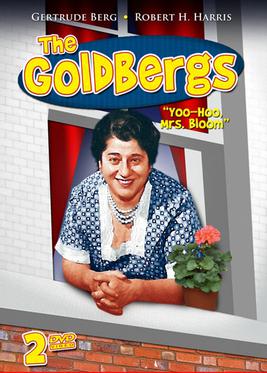
The Goldbergs is a comedy-drama broadcast from 1929 to 1946 on American radio, and from 1949 to 1956 on American television. It was adapted into a 1948 play, Me and Molly; a 1950 film The Goldbergs, and a 1973 Broadway musical, Molly. It also briefly spun off a comic strip from June 8, 1944, to December 21, 1945, with art by Irwin Hasen, a comic book artist who worked on various DC Comics titles and would later do the Dondi comic strip.
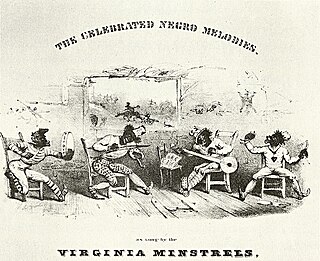
The minstrel show, also called minstrelsy, was an American form of theater developed in the early 19th century. The shows were performed by mostly white actors wearing blackface makeup for the purpose of comically portraying racial stereotypes of African Americans. There were also some African-American performers and black-only minstrel groups that formed and toured. Minstrel shows stereotyped blacks as dimwitted, lazy, buffoonish, cowardly, superstitious, and happy-go-lucky. Each show consisted of comic skits, variety acts, dancing, and music performances that depicted people specifically of African descent.

Calvin and the Colonel is an American animated sitcom about Colonel Montgomery J. Klaxon, a shrewd fox, and Calvin T. Burnside, a dumb bear. Their lawyer was Oliver Wendell Clutch, who was a (literal) weasel. The colonel lived with his wife Maggie Belle and her sister Susan Culpepper, who did not trust the Colonel at all. Colonel Klaxon was in the real estate business, but always tried get-rich-quick schemes with Calvin's unwitting help.
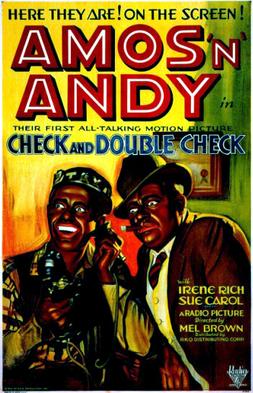
Check and Double Check is a 1930 American pre-Code comedy film produced and released by RKO Radio Pictures, based on the Amos 'n' Andy radio show. The title was derived from a catchphrase associated with the show. Directed by Melville W. Brown, from a screenplay by Bert Kalmar, J. Walter Ruben, and Harry Ruby, it starred Freeman Gosden and Charles Correll in blackface, in the roles of Amos Jones and Andy Brown, respectively, which they had created for the radio show. The film also featured Duke Ellington and his Cotton Club Orchestra.
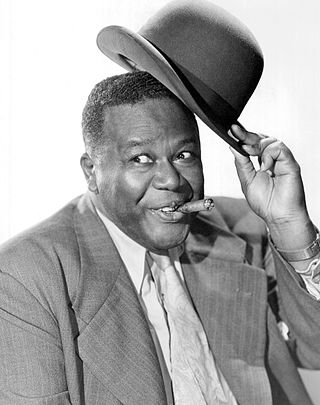
Spencer Williams was an American actor and filmmaker. He portrayed Andy on TV's The Amos 'n' Andy Show and directed films including the 1941 race film The Blood of Jesus. Williams was a pioneering African-American film producer and director.
Beulah was an American situation-comedy series that ran on CBS Radio from 1945 to 1954, and on ABC Television from 1950 to 1953. The show is notable for being the first sitcom to star an African American actress, for being ABC TV's first hit situation comedy, and the first hit TV sitcom without a laugh track. The show was controversial for its caricatures of African Americans.

A black sitcom is a sitcom that principally features black people in its cast. Prominent black sitcoms to date typically come from the United States with African American casts, forming a branch of African American comedy. Although sitcoms with primarily black characters have been present since the earliest days of network television, this genre rose to prominence in the 1990s, mostly then on upstart networks outside the Big Three.
American humor refers collectively to the conventions and common threads that tie together humor in the United States. It is often defined in comparison to the humor of another country – for example, how it is different from British humor and Canadian humor. It is, however, difficult to say what makes a particular type or subject of humor particularly American. Humor usually concerns aspects of American culture, and depends on the historical and current development of the country's culture. The extent to which an individual will personally find something humorous obviously depends on a host of absolute and relative variables, including, but not limited to geographical location, culture, maturity, level of education, and context. People of different countries will therefore find different situations funny. Just as American culture has many aspects which differ from other nations, these cultural differences may be a barrier to how humor translates to other countries.

Flournoy Eakin Miller, sometimes credited as F. E. Miller, was an American entertainer, actor, lyricist, producer and playwright. Between about 1905 and 1932 he formed a popular comic duo, Miller and Lyles, with Aubrey Lyles. Described as "an innovator who advanced black comedy and entertainment significantly," and as "one of the seminal figures in the development of African American musical theater on Broadway", he wrote many successful vaudeville and Broadway shows, including the influential Shuffle Along (1921), as well as working on several all-black movies between the 1930s and 1950s.
Jeff Schaffer is an American film and television director, writer, and producer.
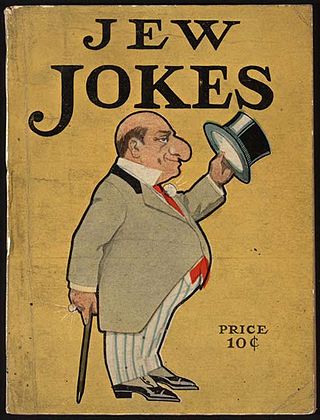
Stereotypes of Jews are generalized representations of Jews, often caricatured and of a prejudiced and antisemitic nature.
The Gumps is an American radio sitcom broadcast from 1931 until 1937, mostly on CBS Radio based on the popular Sidney Smith newspaper comic strip The Gumps. It was the first radio adaptation of comics.
African American comedy has had a substantial role in American culture from minstrel shows, vaudeville, blackface, and coon songs to some of the world's most popular comedians, shows and filmmakers.
















